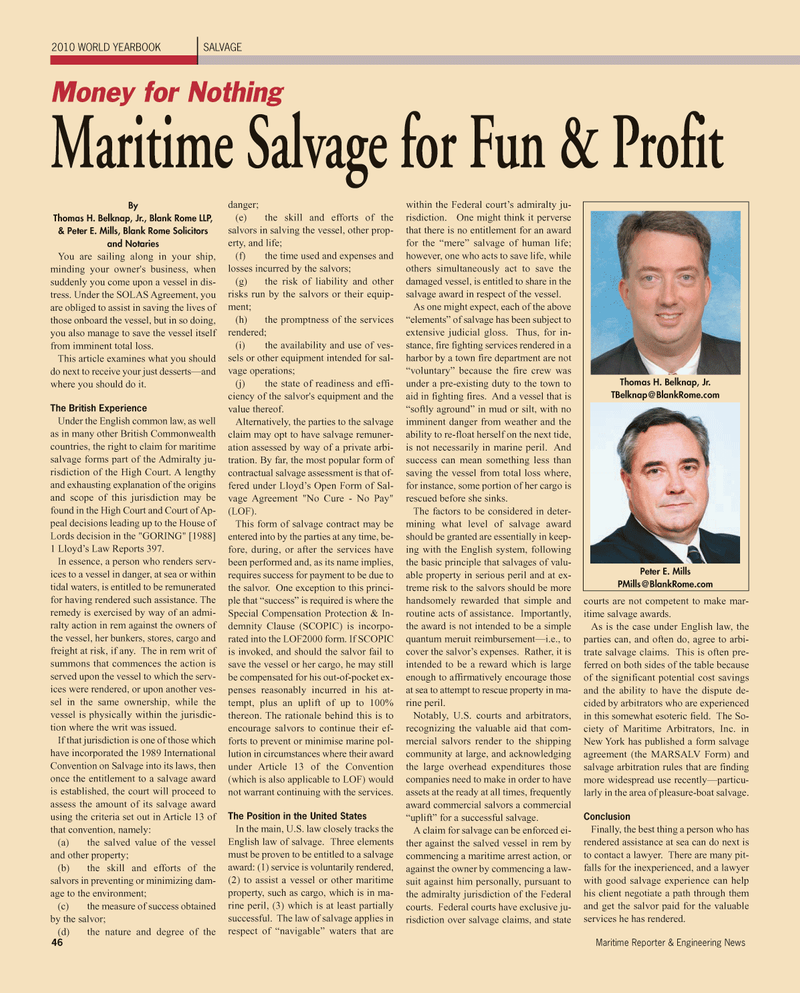
Page 46: of Maritime Reporter Magazine (June 2, 2010)
Read this page in Pdf, Flash or Html5 edition of June 2, 2010 Maritime Reporter Magazine
46 Maritime Reporter & Engineering News 2010 WORLD YEARBOOK SALVAGE
By
Thomas H. Belknap, Jr., Blank Rome LLP, & Peter E. Mills, Blank Rome Solicitors and Notaries
You are sailing along in your ship, minding your owner's business, when suddenly you come upon a vessel in dis- tress. Under the SOLAS Agreement, you are obliged to assist in saving the lives of those onboard the vessel, but in so doing, you also manage to save the vessel itself from imminent total loss.
This article examines what you should do next to receive your just desserts—and where you should do it.
The British Experience
Under the English common law, as well as in many other British Commonwealth countries, the right to claim for maritime salvage forms part of the Admiralty ju- risdiction of the High Court. A lengthy and exhausting explanation of the origins and scope of this jurisdiction may be found in the High Court and Court of Ap- peal decisions leading up to the House of
Lords decision in the "GORING" [1988] 1 Lloyd’s Law Reports 397.
In essence, a person who renders serv- ices to a vessel in danger, at sea or within tidal waters, is entitled to be remunerated for having rendered such assistance. The remedy is exercised by way of an admi- ralty action in rem against the owners of the vessel, her bunkers, stores, cargo and freight at risk, if any. The in rem writ of summons that commences the action is served upon the vessel to which the serv- ices were rendered, or upon another ves- sel in the same ownership, while the vessel is physically within the jurisdic- tion where the writ was issued.
If that jurisdiction is one of those which have incorporated the 1989 International
Convention on Salvage into its laws, then once the entitlement to a salvage award is established, the court will proceed to assess the amount of its salvage award using the criteria set out in Article 13 of that convention, namely: (a) the salved value of the vessel and other property; (b) the skill and efforts of the salvors in preventing or minimizing dam- age to the environment; (c) the measure of success obtained by the salvor; (d) the nature and degree of the danger; (e) the skill and efforts of the salvors in salving the vessel, other prop- erty, and life; (f) the time used and expenses and losses incurred by the salvors; (g) the risk of liability and other risks run by the salvors or their equip- ment; (h) the promptness of the services rendered; (i) the availability and use of ves- sels or other equipment intended for sal- vage operations; (j) the state of readiness and effi- ciency of the salvor's equipment and the value thereof.
Alternatively, the parties to the salvage claim may opt to have salvage remuner- ation assessed by way of a private arbi- tration. By far, the most popular form of contractual salvage assessment is that of- fered under Lloyd’s Open Form of Sal- vage Agreement "No Cure - No Pay" (LOF).
This form of salvage contract may be entered into by the parties at any time, be- fore, during, or after the services have been performed and, as its name implies, requires success for payment to be due to the salvor. One exception to this princi- ple that “success” is required is where the
Special Compensation Protection & In- demnity Clause (SCOPIC) is incorpo- rated into the LOF2000 form. If SCOPIC is invoked, and should the salvor fail to save the vessel or her cargo, he may still be compensated for his out-of-pocket ex- penses reasonably incurred in his at- tempt, plus an uplift of up to 100% thereon. The rationale behind this is to encourage salvors to continue their ef- forts to prevent or minimise marine pol- lution in circumstances where their award under Article 13 of the Convention (which is also applicable to LOF) would not warrant continuing with the services.
The Position in the United States
In the main, U.S. law closely tracks the
English law of salvage. Three elements must be proven to be entitled to a salvage award: (1) service is voluntarily rendered, (2) to assist a vessel or other maritime property, such as cargo, which is in ma- rine peril, (3) which is at least partially successful. The law of salvage applies in respect of “navigable” waters that are within the Federal court’s admiralty ju- risdiction. One might think it perverse that there is no entitlement for an award for the “mere” salvage of human life; however, one who acts to save life, while others simultaneously act to save the damaged vessel, is entitled to share in the salvage award in respect of the vessel.
As one might expect, each of the above “elements” of salvage has been subject to extensive judicial gloss. Thus, for in- stance, fire fighting services rendered in a harbor by a town fire department are not “voluntary” because the fire crew was under a pre-existing duty to the town to aid in fighting fires. And a vessel that is “softly aground” in mud or silt, with no imminent danger from weather and the ability to re-float herself on the next tide, is not necessarily in marine peril. And success can mean something less than saving the vessel from total loss where, for instance, some portion of her cargo is rescued before she sinks.
The factors to be considered in deter- mining what level of salvage award should be granted are essentially in keep- ing with the English system, following the basic principle that salvages of valu- able property in serious peril and at ex- treme risk to the salvors should be more handsomely rewarded that simple and routine acts of assistance. Importantly, the award is not intended to be a simple quantum meruit reimbursement—i.e., to cover the salvor’s expenses. Rather, it is intended to be a reward which is large enough to affirmatively encourage those at sea to attempt to rescue property in ma- rine peril.
Notably, U.S. courts and arbitrators, recognizing the valuable aid that com- mercial salvors render to the shipping community at large, and acknowledging the large overhead expenditures those companies need to make in order to have assets at the ready at all times, frequently award commercial salvors a commercial “uplift” for a successful salvage.
A claim for salvage can be enforced ei- ther against the salved vessel in rem by commencing a maritime arrest action, or against the owner by commencing a law- suit against him personally, pursuant to the admiralty jurisdiction of the Federal courts. Federal courts have exclusive ju- risdiction over salvage claims, and state courts are not competent to make mar- itime salvage awards.
As is the case under English law, the parties can, and often do, agree to arbi- trate salvage claims. This is often pre- ferred on both sides of the table because of the significant potential cost savings and the ability to have the dispute de- cided by arbitrators who are experienced in this somewhat esoteric field. The So- ciety of Maritime Arbitrators, Inc. in
New York has published a form salvage agreement (the MARSALV Form) and salvage arbitration rules that are finding more widespread use recently—particu- larly in the area of pleasure-boat salvage.
Conclusion
Finally, the best thing a person who has rendered assistance at sea can do next is to contact a lawyer. There are many pit- falls for the inexperienced, and a lawyer with good salvage experience can help his client negotiate a path through them and get the salvor paid for the valuable services he has rendered.
Money for Nothing
Maritime Salvage for Fun & Profit
Thomas H. Belknap, Jr.
Peter E. Mills

 45
45

 47
47
